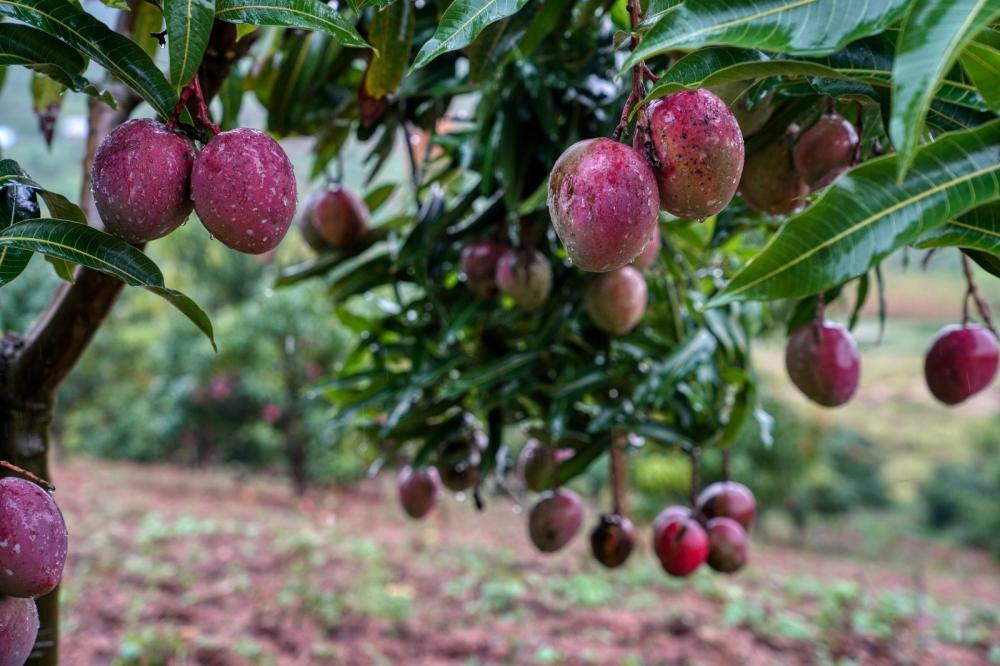Africa-Press – Rwanda. Prudence Sendarasi, a mango farmer in Ntyazo Sector, Nyanza District, has seen steady growth in yields since he began cultivating the fruit as a business on five hectares in 2018.
“I now harvest between 10 and 15 tonnes per two hectares each season,” he said. The yields earn him between Rwf7 million and Rwf8 million per season.
One tree, now about six years old, produces around 80 fruits per season. After recognising the potential, Sendarasi decided to expand his farm by adding three more hectares, although the new trees have not yet matured.
Sendarasi said he initially planted low-quality varieties but later replaced them with improved ones thanks to advice from agricultural experts.
“The varieties I use now produce bigger yields; two mangoes can weigh over one kilogram,” he said, noting that mango trees become more productive with age.
Despite his success, however, Sendarasi cited key challenges affecting mango growing, including limited knowledge in modern farming techniques, pests and access to finance.
Prudence Sendarasi, a mango farmer in Ntyazo Sector, Nyanza District, during interview
“There is a lack of skills in mango farming. Farmers need to engage more with experts and institutions,” he said.
“I managed to install an irrigation system through a government subsidy. I paid Rwf15 million, but I was also servicing another loan. It would help if repayment schedules were aligned with harvests.”
Pests are challenging, but farmers have been adopting measures to curb them.
“We face pests regularly, but with proper support, especially for pesticides and irrigation, we can manage,” he said, urging fellow farmers not to give up and to treat crops as soon as the pests appear.
Depending on the variety and preparation, prices range between Rwf500 and Rwf600 per kilo.
“Fruit flies attack them, and we use pesticides to reduce their impact, while traps can also be used. However, these are not easily accessible, we hope they will become more available in the future.”
Mango trees take a long time before fruits can be harvested, typically around five years, which requires sustained investment in several areas, such as irrigation.
Sendarasi indicated that mango prices are often unstable, and since the fruits are not easily storable, farmers are often forced to sell their produce at giveaway prices.
“If we had facilities for drying the fruits or juice processing factories, farmers would benefit more,” said Sendarasi.
In Bugesera District’s Rilima Sector, 50-year-old Telesphore Hakizimana sees mango trees as a viable business.
“My first mango harvest gave me around 100 kilogrammes, earning Rwf100,000, which I reinvested,” said Hakizimana, who started with 50 trees on a 30-square-metre plot in 2010. “Now, I farm four hectares and harvest about 60 sacks.”
Hakizimana, who makes about Rwf2.4 million in the harvest season, noted that for mango farmers to make good money, they have to see it as a long-term venture, as trees begin to bear fruit after four years.
“Initially, a tree yields about 15-20 kilogrammes, but by the fifth year, that rises to 50-60 kilogrammes. Mature trees can yield up to 100 kilogrammes,” he said.
Pest control remains a challenge, he added.
“We have been trained to manage pests using fungicides and rocket pesticides,” he said, but added that better access to these products is needed in local markets.
Issues with traders
Hakizimana criticised the bulk sale model. “Traders buy mangoes by the sack, not by weight. They cram up to 170 kilogrammes into one sack, and we have no say. We need sales to be based on kilogrammes, not bulk, to reduce losses.”
Hakizimana stressed the need for high-yielding mango varieties that could support new farmers and strengthen Rwanda’s position in the regional market.
“Farming is not easy,” Sendarasi said, “but with determination, government support, and better access to tools, we can overcome the challenges and continue to grow.”
Rwanda targets to increase mango production from 1,200 tonnes in 2024 to 1,632 tonnes in the next five years, according to the Ministry of Agriculture and Animal Resources.
The National Agricultural Export Development Board (NAEB) indicates that the expansion of mango plantations will involve planting grafted seedlings on 200 hectares across two districts, Rusizi in Western Province and Bugesera in Eastern Province.
The initiative will directly engage at least 400 smallholder farmers, contributing to the growth of mango production as part of Rwanda’s import substitution strategy. This effort aims to reduce reliance on mango imports while enhancing the country’s export potential.
NAEB urges farmers to use the already extended support to smallholder farmers through subsidised irrigation schemes, covering up to 50 per cent of the cost for small-scale irrigation equipment under the Small-Scale Irrigation Technology project.
A total of 9,042 mango seedlings are to be planted across various districts. Some 60,000 mango seedlings a projected to be plannted on 200 hectares over the next four years.
The board indicates that the mango farming is one of the ways that can significantly improve their living standards of farmers.
For More News And Analysis About Rwanda Follow Africa-Press






